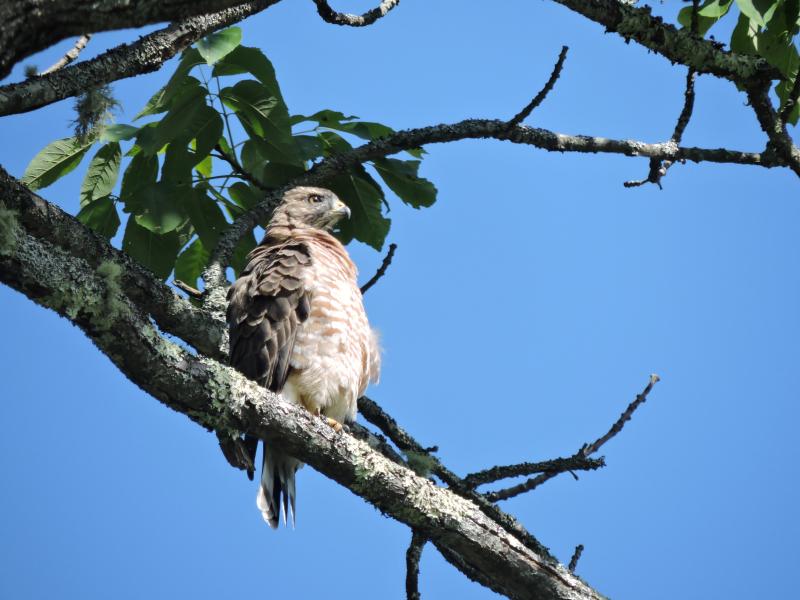Last week during a visit to Mom Wells, we heard the piercing “pit-see” whistle of a broad-winged hawk from somewhere nearby. We stepped out to see if it truly was a hawk or if it could be an excellent imitation by a blue jay. We have been fooled many times by blue jays doing amazingly good renditions of the calls of broad-winged hawks and red-shouldered hawks.
We scanned the ash tree by the driveway and sure enough, there was a slightly ragged looking adult broad-winged hawk sitting about 40 feet up. It gave a few more screeches and then flew to the trees behind the house.
Ten minutes later as Mom was giving a tour of the flower gardens in the back, we heard the distinctive sound again. The bird was back up in the ash tree above the driveway. We were perplexed as to why it seemed to be complaining. This time the hawk was even more persistent and allowed us to get the camera from the house and snap photos from various angles. Finally, after we moved away from the flower gardens, it swept low over the lawn, dropped onto a prey item, and carried it off into the woods.
Our guess was that it had a nest in the woodland behind the house and was anxious to get some food for a young bird that must have been near fledging or recently fledged and still being fed by its parents. Perhaps with us in the yard it was hard for the adult bird to hunt, and its calls were somehow a reflection of that anxiety for us to depart so he or she could get back to the work of hunting.
Mom Wells wondered in hind sight if the presence of an active broad-winged hawk pair nesting nearby might be the reason that she had not seen a chipmunk in the yard for months when most summers they were abundant.
Broad-winged hawks are one of our most migratory of hawks. Red-tailed hawks, Cooper’s hawks, sharp-shinned hawks and others can be found in Maine even in the winter. But all of our broad-winged hawks depart in the fall and make an incredibly long journey all the way to South America. Also unlike most other hawks, broad-winged hawks make those long journeys in loose flocks that are called “kettles” (as we have written about in past columns).
Broad-winged hawks are one of the more common hawks in Maine but are often overlooked because they inhabit woodland where they can pass relatively unseen. Their stick nests can even be in forest areas quite close to houses or cottages, but the thick leaves are effective in hiding the nest and the birds’ comings and goings.
If you learn that piercing whistled call you too may quickly discover that broad-winged hawks are your neighbors, as was the case, we found, in Mom Wells’ neighborhood. You may have to wait to discover this next year, though, because broad-wings begin migrating as early as mid-September. Most have usually departed Maine by mid-October as they race south toward Texas, the Atlantic coast of Mexico and Central America, on the way to their South American wintering grounds—where they will live in a neighborhood very unlike Mom Wells’ here in Maine!
Jeffrey V. Wells, Ph.D., is a Fellow of the Cornell Lab of Ornithology and Vice President of Boreal Conservation for National Audubon. Dr. Wells is one of the nation's leading bird experts and conservation biologists and author of “Birder’s Conservation Handbook”. His grandfather, the late John Chase, was a columnist for the Boothbay Register for many years. Allison Childs Wells, formerly of the Cornell Lab of Ornithology, is a senior director at the Natural Resources Council of Maine, a nonprofit membership organization working statewide to protect the nature of Maine. Both are widely published natural history writers and are the authors of the book, “Maine’s Favorite Birds” and “Birds of Aruba, Bonaire, and Curaçao: A Site and Field Guide” from Cornell Press.






























